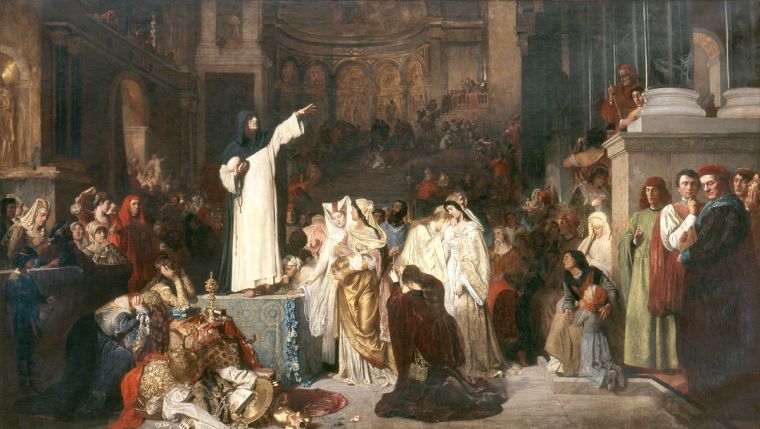The 'bonfire of the vanities': One Christian reformer's passionate purge of sinful distraction
On this day in 1497 there occurred a dramatic public display of zealous, religiously-minded arson. The great 'bonfire of the vanities' targeted numerous objects deemed dangerous temptations to sin by the passionate instigator of the purge, Dominican friar Girolamo Savonarola.
Savonarola had joined the Dominicans in his early twenties, making a radical break from his family and the professional path on which he had been set. He became a devoted preacher in northern Italy, prophesying doom for despots and corrupt clergy whilst imploring repentance and civic and spiritual renewal.
His public addresses targeted tyrants and appealed for justice on behalf of the poor, winning him an impressive following – thousands flocked to hear his messages. Savonarola opposed the corruption of Pope Alexander VI and challenged the might of the establishment Medici family.

Abbot at San Marco, Florence, he was devoted to this city in particular, determined to rid it of vice and see it restored, resounding with righteous glory.
As part of this, he saw it necessary for the city to be rid of distractions that drew the faithful away from God. This meant any books, artworks, instruments or personal luxuries that could tempt one to sin. Christian art for example, should be piously-minded and draw one to devotion: not be a frivolous or titillating form of entertainment. So began his 'bonfire of the vanities' (the name is generally attached to this event but similar practices preceded and followed Savonarola) on February 7, 1497, as Dan Graves explains at Christianity.com.
This was not a Protestant kind of iconoclasm that opposed any religious imagery or church decoration, but rather targeted what was deemed to be excessive and tending to sin. Tapestries, sculptures, and manuscripts considered dangerous were burned. Mirrors, cosmetics, and books of astrology and magic faced the fire too.
A year later however, the city's fortunes had not improved but fallen, many faced starvation amidst economic calamity. The crowd turned against the Dominican, and one Franciscan called for the friar to face fiery destruction himself.
He was later arrested, interrogated and urged to recant his teaching by the ruling church authorities. He vigorously resisted, and for his insolence was sentenced to death, executed and consumed by fire on May 23, 1498.
Savonarola's impassioned 'bonfire of vanities' may be regarded as hysterical or aggressively conservative today. Others might applaud his clear commitment to excising attachments that led one to vice, a responsible restraint perhaps not present enough for some contemporary believers. This Dominican arguably found himself caught up in a fifteenth-century 'culture war', one fraught with religious and political division and confusion. The Catholic Church would later embrace his more conservative leanings on art and material possessions. Unfortunately for Savonarola, he found crowds to be fickle and fires, whether for books or for himself, all to easily ignited.











